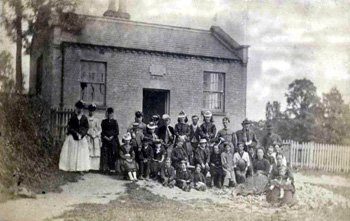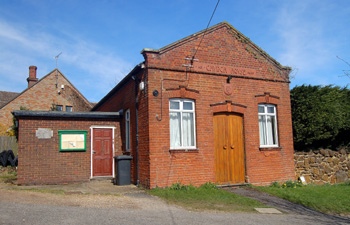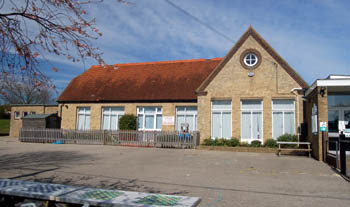Education in Tilsworth
Volume 81 published by Bedfordshire Historical Records Society (2002) is a series of episcopal visitations undertaken in the first twenty years of the 18th century, edited by former County Archivist Patricia Bell. At each visitation a list of questions was sent out in advance, one of which enquired about the provision of schools in each parish. The various replies for Tilsworth were as follows:
- 1706: "There is no School, Almeshouse, or Hospitall in this Parish";
- 1709: "No public or charity Schole";
- 1717: "Schools We have none";
- 1720: "Schools We have none".
In 1818 a Select Committee was established to enquire into educational provision for the poor. This was no doubt prompted, in part, by the recent foundation of two societies promoting education and specifically the building of schools. The Society for Promoting the Lancasterian System for the Education of the Poor was established in 1808 promoting schools run along the lines pioneered by Joseph Lancaster, who had himself copied those of Dr.Andrew Bell, in which older children taught their younger fellows. The Society was renamed the British and Foreign School Society in 1814,. It was supported by a number of prominent nonconformists, Lancaster himself was a Quaker, and sought to teach a non-sectarian curriculum. In answer to this perceived nonconformist takeover of local education the National Society was firmed in 1811 to encourage the teaching of poor children along Anglican lines, including the catechism. The Select Committee sent a questionnaire to all parishes in the country asking for: particulars relating to endowments for the education of children; other educational institutions; observations of parish needs etc. The return for Tilsworth stated that there was no endowment or school simply that: "The poor are desirous of possessing the means of education".
In the country generally the number of schools built continued to grow over the next fifteen years so that by 1833 the government agreed to supplement the work of the two societies, and local benefactors, by making £20,000 per annum available in grants to help build schools. It also prompted another questionnaire to be sent to each parish in England asking for details of local educational provision. The response from Tilsworth stated that there was now a daily school "in which 14 males and 18 females are taught to read and make straw-plait, at the expense of their parents". Sources of this period elsewhere express annoyance with and contempt for these plait schools, implying that all they really did was teach plaiting, the plait being sold to the hat makers in Luton. Whether this was true of Tilsworth plait school it is impossible to say. Tilsworth also had a Sunday School which had opened in 1824 and taught 31 males and 32 females, supporte by subscription. At this date Sunday Schools were just that, schools which met on a Sunday at which subjects such as readin gand writing would be taught along with the religious instruction which remains their sole purpose today. The Sunday School probably met in a room on the site of the current Church House.
The next national enquiry was in 1846/7 when the Church of England made an enquiry as to all its church schools. This was against the background of a new Whig government which championed secular education and the increasing importance of nonconformists, particularly Wesleyan Methodist, and Roman Catholics in providing schools. The Tilsworth return stated simply: "A Sunday school has been recently established in this parish"; it is not clear if twenty years or so previously could be regarded as recent or whether that school had failed and another one started.

Tilsworth Infants School in the 1870s [P130/28/5/11]
The first Education Act was passed in 1870 (more correctly it was known as the Elementary Education Act). It was a milestone in the provision of education in Britain demonstrating central government's unequivocal support for education of all classes across the country. It also sought to secularise education by allowing the creation of School Boards. These were groups of representatives, elected by the local ratepayers and the Board had the powers to raise funds to form a local rate to support local education, build and run schools, pay the fees of the poorest children, make local school attendance compulsory between the ages of 5 and 13 and could even support local church schools, though in practice they replaced them, turning them into Board run schools (known as Board Schools). Naturally, and luckily for local historians, the Act required a questionnaire of local schools in 1870. The response from Tilsworth was united with that for Eggington and Stanbridge but specifically noted a school for 27 infants in Tilsworth, slightly puzzlingly it went on: "If Tilsworth School be converted into an infants' school and at once made efficient by providing a gallery and appointing a certificated teacher, the accommodation mentioned…will not be required". This simply seems to mean that the school at Tilsworth was not being run on formal lines and there was a belief that it should be. The school was on the site of the current Church House.

Tilsworth Church House March 2008
A School Board for Eggington, Stanbridge and Tilsworth was formed in 1874. The Board was, however, dismissed by the Board of Education in 1880 for failing to provide a new school and a new Board was imposed. By 1884 a new school (in Stanbridge) had been built and the district returned to an elected School Board, from that date no children were educated in Tilsworth, children from that parish attending school in Stanbridge.

Stanbridge Lower School March 2008